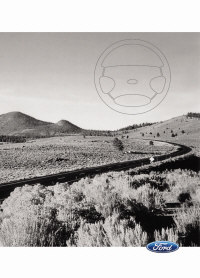This view of the Owner’s Manual contains the very latest information, which may vary slightly from the printed Owner’s Manual originally provided with your vehicle. It may also describe content that is not on or operates differently on your vehicle. Please consider the Owner’s Manual originally provided with your vehicle as the primary source of information for your vehicle.

The information contained in this publication was correct at the time of release.In the interest of continuous development, we reserve the right to change specifications, design or equipment at any time without notice or obligation.No part of this publication may be reproduced, transmitted, stored in a retrieval system or translated into any language in any form by any means without our written permission.Errors and omissions excepted.
Copyright © 2024 Ford Motor Company
Starting a Gasoline Engine
When you start the engine, the idle speed increases, this helps to warm up the engine. If the engine idle speed does not slow down automatically, have your vehicle checked by an authorized dealer.
Before starting the engine check the following:- Make sure all occupants have fastened their safety belts.
- Make sure the headlamps and electrical accessories are off.
- Make sure the parking brake is on.
- Make sure the transmission is in park (P) or neutral (N).
- Turn the ignition key to the on position.
Note:
Do not touch the accelerator pedal.
- Fully press the brake pedal.
- Turn the key to the start position to start the engine. Release the key when the engine starts.
Note:
The engine may continue cranking for up to 15 seconds or until it starts.
Note:
If you cannot start the engine on the first try, wait for a short period and try again.
Failure to Start
If you cannot start the engine after three attempts, wait 10 seconds and follow this procedure:
- Fully press the brake pedal.
- Shift into park (P).
- Fully press the accelerator pedal and hold it there.
- Attempt to start your vehicle and wait until the engine stops cranking.
- Release the accelerator pedal.
- Start the engine.
Stopping the Engine When Your Vehicle is Stationary
- Shift into park (P) or neutral (N).
- Turn the key to the off position.
- Apply the parking brake.
Stopping the Engine When Your Vehicle is Moving
 WARNING:
Switching off the engine when your vehicle is still moving results in a significant decrease in braking assistance. Higher effort is required to apply the brakes and to stop your vehicle. A significant decrease in steering assistance could also occur. The steering does not lock, but higher effort could be required to steer your vehicle. When you switch the ignition off, some electrical circuits, for example airbags, also turn off. If you unintentionally switch the ignition off, shift into neutral (N) and restart the engine.
WARNING:
Switching off the engine when your vehicle is still moving results in a significant decrease in braking assistance. Higher effort is required to apply the brakes and to stop your vehicle. A significant decrease in steering assistance could also occur. The steering does not lock, but higher effort could be required to steer your vehicle. When you switch the ignition off, some electrical circuits, for example airbags, also turn off. If you unintentionally switch the ignition off, shift into neutral (N) and restart the engine. |
- Put the transmission into neutral (N) and use the brakes to bring your vehicle to a safe stop.
- When your vehicle has stopped, shift into park (P) or neutral (N) and switch the ignition off.
- Apply the parking brake.
Guarding Against Exhaust Fumes
 WARNING:
Exhaust leaks may result in entry of harmful and potentially lethal fumes into the passenger compartment. If you smell exhaust fumes inside your vehicle, have your vehicle inspected immediately. Do not drive if you smell exhaust fumes.
WARNING:
Exhaust leaks may result in entry of harmful and potentially lethal fumes into the passenger compartment. If you smell exhaust fumes inside your vehicle, have your vehicle inspected immediately. Do not drive if you smell exhaust fumes. |
Important Ventilating Information
If you stop your vehicle and then leave the engine idling for long periods of time, we recommend that you do one of the following:
- Open the windows at least 1 in (3 cm).
- Set your climate control to outside air.
Thank You For Your Feedback
